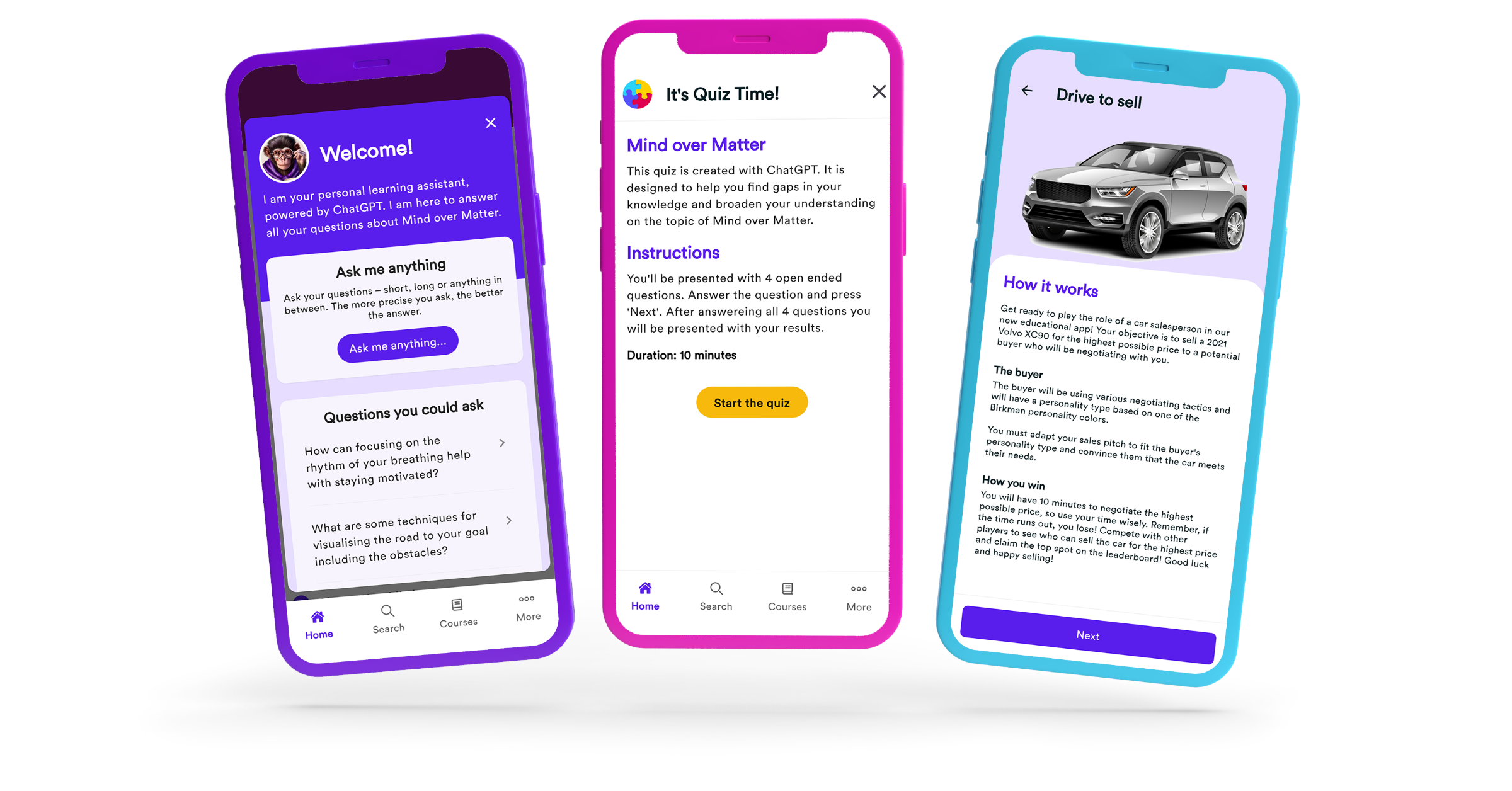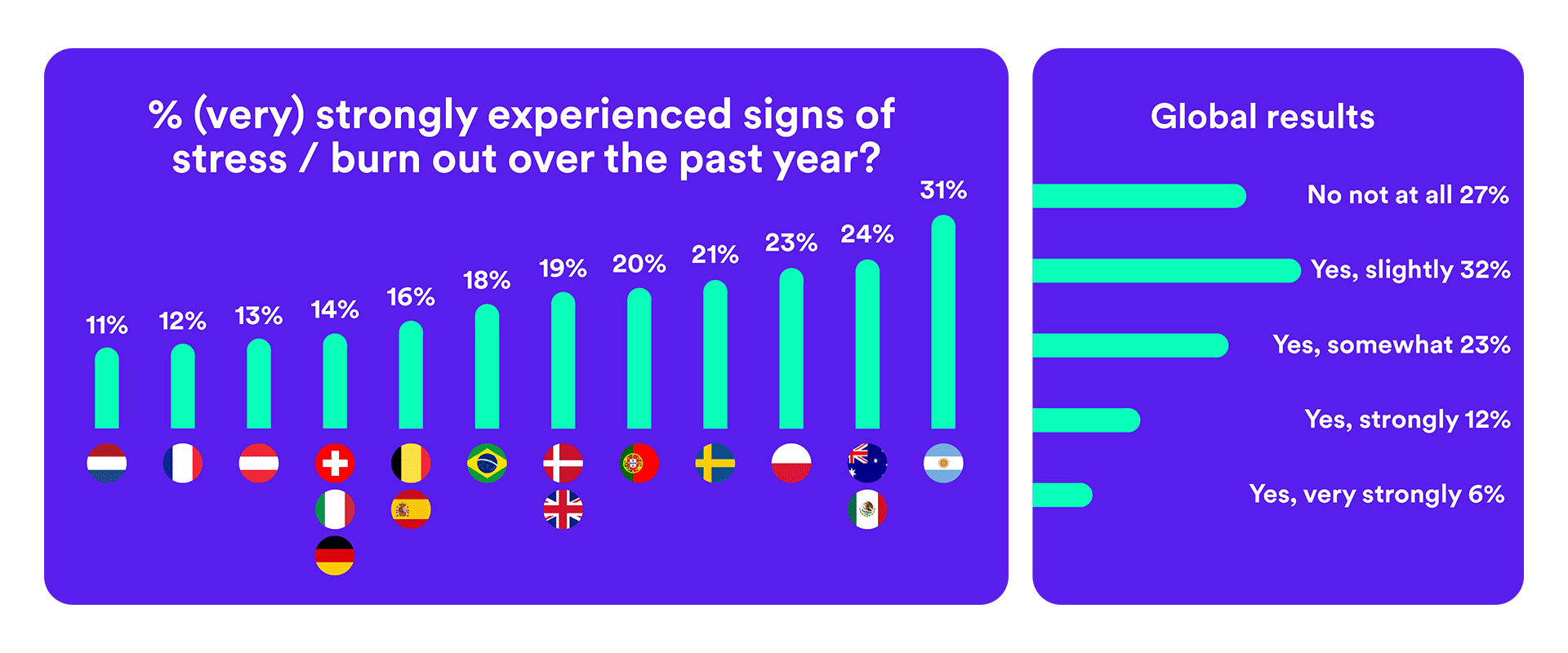
A quick overview:
- AI automation in L&D.
- The impact of upskilling with micro-learning.
- Learning in the flow of work.
- The impact of the hybrid workforce on leadership and L&D.
- Next-level mental health and wellbeing support.
- Aligning with business goals.
But first, let’s have a quick look back at 2023.
Has this past year looked like what you’ve predicted? Looking at the usage of our educational content, the competency Technology & Expertise has remained a top priority for professionals around the world. Online courses like Information Security and GDPR-compliant top the list. Also, Teamwork and communication skills are trending in our online platform. Titles like Exciting Meetings, Conversation Technique LSD, and Teamwork have been among the favourites of our users.
Ready to look ahead? Combined with the LPI’s data, we’ve been able to reflect on the challenges highlighted in their report, from L&D and HR managers, to highlight the most relevant trends for 2024. Let’s jump right in!
Trend no. 1: AI automation in L&D.
Surprise, surprise, we’re kicking off this list with the endless possibilities of AI automation. No one could’ve imagined the undeniable impact that AI technology has had on the world in the past 12 months alone, and it doesn’t seem to be slowing down anytime soon. And while AI might seem scary, it can be the solution to many challenges organisations face. According to LPI research, 83% of learners say that they don’t have time during the workday to spend on personal development. Self-directed insight isn’t possible if people can’t manage the work balance: the solution is to support engagement.
Research shows that immersive training methods facilitated by AI can reduce time spent on training by 40%, while also increasing performance ratings by 70%. Allowing interactive elements to take the lead in learning will undoubtedly create higher levels of engagement—which is one of the top challenges for L&D leaders, according to attendees at the LPI’s LEARNING LIVE conference. GoodHabitz integrates AI into its ‘Drive to Sell’ feature (and much more), where a roleplaying exercise teaches an employee how to adapt their communication style to have more impactful outcomes. The incredible rise in AI also shows a strong need for experts on automation, as businesses (should) shift more towards leveraging such tools.
“The power of AI lies in its innovation in an organisation, in how adaptive it is, in how it creates value. Used intentionally, it can bridge knowledge gaps and foster a productive and personalised learning environment for employees through accessible and tailored content. Implementing AI to improve learner experience is the way forward in promoting self-directed learning and development.” - Jaap Koelewijn, Innovator and AI Director.

Trend no. 2: The impact of upskilling with micro-learning.
The hybrid workplace presents many challenges, particularly when the demand for upskilling and reskilling is accelerating. Research shows that 44% of employees believe that the skills that are currently required will transform rapidly over the next five years. Motivating and engaging the learner is what will make a difference to the future of L&D, making it all the more important to select content which will meet the exact needs of your employees. As already mentioned, using AI tools allows organisations to promote an agility of learning: to make accessible content on-demand and easily located.
This is why upskilling remains to be, not only an important, but an essential element of L&D strategy that shouldn’t be taken for granted. The LPI’s research shows that engaging the learner is one of the crucial challenges for L&D professionals and using AI to allow your employees to stand out against the crowd will help achieve organisational business objectives. Micro-learning has the ability for L&D leaders to highlight and mould content to meet specific challenges, which means organisations can provide learners with content that is more enticing and engaging.
GoodHabitz strives to make learning as accessible as possible through making the most of AI tools. Accessibility is crucial to sustaining an ethos that supports employees learning at a time and place that suits them. Our mobile app allows employees to learn whenever and wherever, which shows how the flexibility of micro-learning can boost employee self-directed learning on the move. Providing employees with supportive content in the flow of work supports this self-directed learning culture.
Trend no. 3: Learning in the flow of work.
LPI’s report states that a transformation in workplace learning, centred around technology, is on the horizon for 2024. Generative AI tools and micro-learning are set to make waves in the realm of personalisation and engagement in the L&D landscape. Micro-learning can enable learning in the flow of work, so that dedicating time to learning and development to no longer be seen as an interruption to the daily work (and life) routine. Finding time in a busy day can be tough, so allowing employees to pick and choose to learn at their preferred moment will achieve the most effective results. For example, our WorkOuts offer peer-to-peer learning methods to support this.
“Many people call it learning in the flow of work, but I prefer ‘ learning in the flow of life’. On a day-to-day basis working remotely, people are dealing with many other aspects of life besides work-related issues. The key is to make learning so that it isn’t seen as an interruption to our daily routines.” - Giles Hearn, Chief Marketing Officer, LPI.
Navigating the sea of daily tasks can make prioritising personal development tricky. According to a CIPD survey, time and engagement are two of the biggest blocks that employees desire to focus on in L&D. Giles Hearn, CMO at the LPI also supports that “lack of time is the number one reason why people aren’t engaging with learning”. So, how can you get your employees to want to focus on personal development?
“Learning in the flow of work is encouraging a bite sized approach to learning and learning at the point of need. Furthermore, L&D leaders can invigorate peer-to-peer learning during team meetings via WorkOuts and create pathways that meet departments specific learning needs. If we put the right content in front of the learner – they will feel motivated to dip into it (as and when they find the time)” - Martin Coles, Customer Success Coach, GoodHabitz.
Trend no. 4: The impact of the hybrid workforce on leadership and L&D.
Employees have made a return to the office, but not on a full-time basis. According to Advanced Workplace, only about 3% of employees would want to return to the office 5 days a week. As a result, this influences the need for a different style of leadership. Leaders need to be authentic in their approach to managing the different needs of an organisation.
The category of Inspirational Leadership is one of our most popular, with the course ‘Innovate Yourself’ having a completion rate of 85%. This supports the need for effective leadership training that is engaging and inspiring and can bridge the gap between working from home and in the office. Giles Hearn from the LPI also reveals that there is a need for L&D leaders to structure effective leadership training using the relevant technology.
At GoodHabitz, we offer online training solutions that facilitate the hybrid workspace, with an online learning library of courses that can be taken at a time and place that suits employees. Being in line with a hybrid set up of online classrooms and learning means the support is there for employees to embrace working on their personal development at their pace.
Trend no. 5: Next-level mental health and wellbeing support.
According to our own research, 1 in 5 employees experienced (very) strong signs of stress/burnout in the past year. Globally, 12 billion working days can be saved every year with better mental health and wellbeing support. So, it’s a no-brainer that prioritising employees’ mental health can unlock higher potential in your workforce. Happy and healthy employees are the catalyst for organisational success!
The disconnect of working from home can create more distance, making it more difficult to open up. The LPI similarly shines a light on the pivotal role of enhancing wellbeing in a hybrid landscape—the synergy of growth and support should elevate the workplace environment! For example, GoodHabitz offers WorkOuts, which invite employees to discuss and reflect on any course and assessment found in the GoodHabitz library. It also offers a way for teams to learn together—and teamwork makes the dream work after all!
Creating a vibrant mental health culture is all about shining the spotlight on self-insight. When employees feel supported by their organisation, self-insight and awareness can flourish. The LPI’s reportalso believes that putting effective leadership in place will help normalise mental health conversations in the workplace. Emphasising the importance of self-insight means that employees can feel supported to be proactive in their own mental health and wellbeing.

Trend no. 6: Aligning with business goals.
The Learning at work 2023 Survey shows that the business value that L&D delivers has decreased. Which is why 2024 is a critical year for L&D teams to align their priorities with delivering concrete business objectives. In the past, employee learning has often been seen as ‘nice to have’ or something employees must do. But not anymore! Younger generations of talent expect L&D opportunities (reasons 5 & 6), making learning a main driver towards business success. There is a realisation that whilst providing access to a vast content library has value, the most effective organisations are exploring the requirements of their workforce in more detail and then providing pathways to meet their specific needs and objectives.
Aligning L&D initiatives with business goals not only allows learning leaders to quantify the impact of training, but also fosters a culture of continuous improvement and adaptability. By directly connecting individual development efforts to overarching business objectives, organisations can optimise resource allocation, improve employee engagement and strategically position themselves for long-term success in a dynamic and competitive landscape.In addition, whilst proving the value of L&D efforts is often underpinned by KPIs around employee performance and engagement, 2024 is a crucial year for learning leaders to highlight the cost of inaction (COI) and the risks posed by having a workforce that hasn't developed their skillset in line with business needs.
From knowledge to action.
So now we’ve surfed the wave of trends: what’s next? How can you best prepare for the for the ever-evolving world of L&D in 2024?
By being in sync with the pulse of the evolving L&D landscape, you'll not just adapt but thrive in the dynamic future of professional development. Employees can’t prescribe their own medication when it comes to L&D, so it’s up to organisations to be on top of the learning needs and keep the entire workforce happy and productive! This means engaging the learner, leveraging the correct AI tools and offering on-demand online learning formats to cultivate a successful learning culture.
We’re ready to thrive in the new year, and we hope you are too! Continuous growth never stops, and we’re geared up to enhance learning experiences for 2024.
